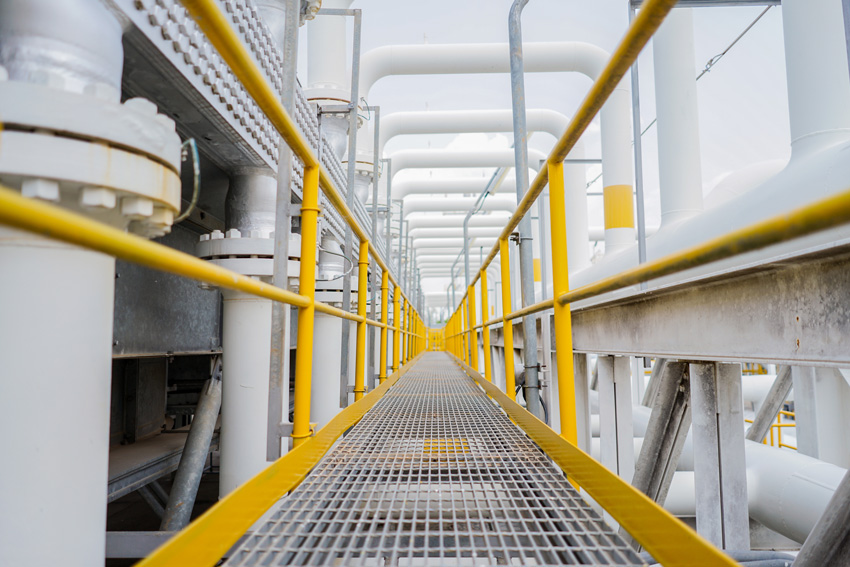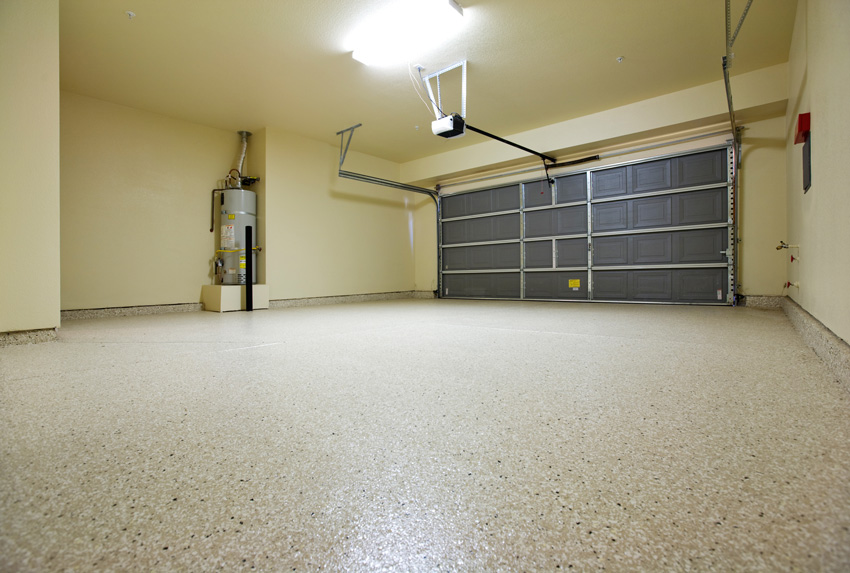An Introduction to High-Performance Coating Systems (Article Course)
High-Performance Finish Coats
Earlier we talked about the importance of the layering system with high-performance coatings. Each layer has a specific purpose, but the finish coat—also known as the top coat—addresses not only performance and protection but also aesthetics. As the visible layer, this coat has a role in the overall look of the finished project, but it also works as a first line of defense against the elements, abrasion, chemicals, and other factors. If we think about this from the top-down approach, finish coat selection will need to address aesthetic and performance goals, and it will need to be able to handle the environmental conditions of exposure, whether indoor or outdoor.
Pre-Catalyzed Waterborne Wall Epoxy (One-Component Product)
This finish is designed specifically for interior walls—including drywall. The epoxy resin is incorporated into the coating during the manufacturing process and, contains low levels of volatile organic compounds (VOCs), and cleans with water. As a finish, this epoxy is easy to apply and is very durable. The quick and easy cleaning characteristics make this finish an excellent choice for retail and commercial properties, as well as health-care facilities and schools. Walls in the hallways, gyms, locker rooms, and cafeterias are all subject to frequent abuse that require a durable finish that can withstand repeated scrubbing. In addition to performance, this coating is available in a wide range of colors and sheens to meet the aesthetic needs of a property.
Waterborne Amine Epoxy (Two-Component Product)
Another epoxy option is a waterborne amine epoxy. The finish has characteristics of resisting chemicals, abrasions, and impacts, and it can be used on substrates ranging from steel, iron, and concrete to nonferrous materials, wood, and drywall. As a water-based epoxy, it has lower odor than solvent-based epoxies, which means it can be applied in occupied spaces. The finish is easy to apply, rugged, and durable. Typical uses include concrete floors that get a lot of foot traffic, such as in a garage, arena, basement, warehouse, or in high-traffic commercial areas. Such sites need the flooring to be durable and safe, and the finish needs to adhere extremely well to the substrate. This finish is part of a specific system that requires careful preparation of the substrate followed by a primer and then the finish coat. While aesthetics are not the primary goal of this finish, flakes can be applied to enhance the visual appeal while working to hide dirt and grime.
Alkyd Urethane Enamel (One-Component Product)
Enamel finishes provide both rugged durability and a smooth, glossy appearance, and they make a good maintenance coating. In addition to durability and gloss, an alkyd urethane enamel has the key characteristics of excellent surface tolerance so they work well with surfaces that are less than perfect. They also cure to a hard, scratch-, and impact-resistant finish. From a practical standpoint, enamel finishes are easy to apply with spray, brush, or roller. However, traditional alkyd enamels, while maintaining some popularity because of their application and adhesion properties, are declining in use because of VOC restrictions and use of solvents.
Typical uses for this enamel finish include exterior spaces such as fences, outdoor equipment, or anything that needs to stand up to a lot of wear and tear and abuse, although the finish may chalk and fade over time from UV exposure and harsh weather conditions. An example of applications where this finish might be used are parks, amphitheaters, and amusements parks—spaces that demand performance and require bright, glossy color for aesthetic appeal.
Acrylic Direct-to-Metal (DTM) Enamel (One-Component Product)
Another enamel finish option is an acrylic direct-to-metal finish. This type of finish is best for light-to-moderate industrial and commercial use, but it also works well in select residential situations where metal surfaces need to be coated quickly, such as exterior doors or railings in an apartment complex. DTM enamel is corrosion, UV, and moisture resistant. While designed for metal, this coating also can be used to provide a smooth, durable finish on a variety of substrates, including wood, drywall, and masonry. A direct-to-metal enamel finish is particularly useful for structures that get a lot of physical abuse and that may need to be repainted occasionally. For example: ballparks, event arenas, and factories include railings that need to be kept strong and safe, and a finish that can be applied on a variety of surfaces, dries quickly, and adheres well is ideal.
Aliphatic Acrylic Urethane (Two-Component Product)
As a finish option, an aliphatic acrylic urethane offers high-end performance and color retention for exterior surfaces that are exposed to rain and sunlight. This finish may be used as the top layer on masonry or metals, and it requires subcoats of primer and epoxy. Its characteristics include resistance to UV rays, chemicals, abrasion, and hydraulic fluids—all of which make it an excellent coating for industrial applications. This coating is ideal for situations that require long-lasting surfaces with minimal maintenance; for example, the exterior of a large industrial tank or as a finish coat on a high-performance floor system. In addition to resisting scratches, abrasion, and impacts, the coating’s durability and gloss also help it resist graffiti while improving the longevity of the substrate.
Environmental and Operations Conditions That Influence Coating Performance and Service Life
Regardless of whether a high-performance coating system is used for an architectural or industrial project, the coating will be exposed to varying environmental and operations conditions. These conditions can be anything from the day-to-day activity in a hot restaurant kitchen with splatters and spills and constant cleanup to grease and chemical stains in a garage or industrial setting. Regardless of the situation, these conditions will influence how well and how long the coating will perform.
Environmental Conditions
Environmental conditions apply to both interior and exterior spaces. Many interior spaces have challenging indoor environments that can influence how well a coating performs. For example, schools can have spaces such as swimming pools and gymnasiums where humidity levels are high, kitchens can get very hot, and factories may be exposed to harsh environments with particulate matter within the space. Exterior spaces experience more varied environmental conditions, and structures in some climates are subjected to freeze-thaw conditions and salt exposure in the winter. Humidity, UV exposure, salt, particulate matter, and both substrate surface and surrounding air temperature all contribute to the localized environment that can affect a coating’s application and adhesion, performance, and service life. Each of these conditions affect different substrates in different ways.
Moisture is one of the more common issues that impacts coatings, in part because it can arise under many different conditions. The combination of the right air to surface temperatures and higher humidity can cause dew that may condense on a surface. It should come as no surprise that in a very warm, humid environment, coatings will take longer to dry—this is because warm air holds more moisture than cold air. The point is that high humidity can cause moisture vapor to condense on the substrate surface, which can result in slow curing rates, problems from aesthetic defects, rust, or performance flaws.
Moisture-related issues may be mitigated by monitoring the humidity and dew point during application and applying the product only when the surface temperature is a minimum of 5 degrees Fahrenheit above the calculated dew point.

Humidity, UV exposure, salt, particulate matter, and both substrate surface and surrounding air temperature all contribute to the localized environment that can affect a coating’s application and adhesion, performance, and service life.
Other challenges can emerge such as high air flow, which can affect curing, and direct sunlight, which can affect longevity. UV exposure, in particular, can dull a coating’s color over time, and it can eventually break down the coating material. Particulate matter and salt also can compromise a successful application of the coating and impact longevity. Chlorides (salts) on a surface affect longevity because salts have an affinity for water and in extreme cases can actually draw water through the paint film.
Physical Conditions
Once a high-performance coating system is properly applied, it is inevitably exposed to the very factors it is designed to resist. In some cases, this may be chemical exposure, such as in an industrial setting or laboratory setting and in other cases, physical conditions may include abrasion, impact, and simply long-term wear and tear. That said, a high-performance coating system that is appropriately specified and correctly applied should withstand the physical conditions it was designed and tested to protect against.

A high-performance coating system that is appropriately specified and correctly applied should withstand the physical conditions it was designed and tested to protect against.
Project Requirements that can Limit Coating Options
Different project requirements can affect the coating options. Exterior projects may be affected more by environmental conditions, whereas interior projects rely on the coating to ensure a safe and healthy indoor environment during an immediately after application. Odors, VOCs, and application turnaround as well as dry times can be critical factors in interior projects, especially if the space is occupied. Projects such as hospitals, for example, must have the proper paint applied (e.g., low odor, no VOC) in order to avoid affecting patients and staff—and to ensure the facility can remain open. The same holds true for any occupied space. New construction is a different matter, especially if occupants are not an issue, but such projects may have requirements that limit what coating options are appropriate.

Odors, VOCs, and application turnaround as well as dry times can be critical factors in interior projects, especially if the space is occupied.
Other considerations are whether the coatings can be applied at night or weekends, when no one is likely to be affected by odors or potential VOCs. Off-hours can help if the paint has a longer drying time and needs time to cure before the surfaces are safe to touch or be around. Yet if there are limits to proper preparation—for example, not enough time to properly prepare the substrate before the coating is applied—the performance and longevity of the coating might be compromised.










